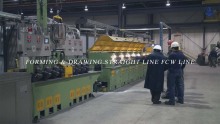轧辊Co-Ni-Cr tungsten carbide rolls manufacturer
Co-Ni-Cr tungsten carbide rolls Element
The composition of tungsten carbide rolls is different due to the different working conditions of the rolls, even the composition of the rolls of different stands in the same finishing mill. The rolls for high-speed wire rod mills are mainly tungsten carbide rolls with cobalt as the binder. A few continuous casting and rolling mills also use Co-Ni-Cr tungsten carbide rolls as binders due to poor water quality, and the cost is also low.
 Audited supplier
Audited supplierCo-Ni-Cr tungsten carbide rolls performance
The hardness of tungsten carbide rolls increases with the increase of TC content; while the toughness increases with the increase of binder phase content.
Tungsten carbide roll has high hardness, and its hardness value changes little with temperature. The hardness value at 700℃ is 4 times that of high-speed steel; and the elastic modulus, compressive strength, bending strength, and thermal conductivity are also high. More than 1 times of tool steel. All these properties ensure that tungsten carbide rolls have much better wear resistance and deformation resistance than tool steel rolls in the working process, thereby ensuring the smoothness and dimensional constancy of the roll grooves, which is essential to ensure the surface quality of the wire rod. And dimensional accuracy is crucial. Due to the high thermal conductivity of the tungsten carbide roll, the heat dissipation effect is good, and the time that the roll surface is at a high temperature is short, so that the high temperature reaction time of the roll with harmful impurities in the cooling water is short. Therefore, tungsten carbide rolls are more resistant to corrosion and thermal fatigue than tool steel rolls.
Tungsten carbide rolls are produced by powder metallurgy using tungsten carbide powder and cobalt powder (a small amount of other hard phases or alloying elements can also be added) as raw materials. The above two powders were wet-milled and mixed with a ball mill. After the materials are uniformly mixed, they are dried and sieved to become the intermediate product-cemented carbide mixture. The mixture is pressed and sintered to become a roll blank. The roll blank is polished or re-grooved to become a production roll.
Density, hardness, bending strength, impurity content, surface roughness, material porosity, WC grain size, total carbon and free carbon content, magnetic saturation strength, coercivity, etc. In addition, there are also the processing accuracy of the rolls and so on. The level of each index reflects the quality of the roll and indicates its performance.
 Audited supplier
Audited supplier
Best Flux Cored Wire Forming & Drawing Machine Supplier | Three Water Machinery

Best Quality Flux cored wire Rolling and Forming Line drawing machine Factory

Professional flux-cored welding wire equipment manufacturers drawing machine

BEST FCW Drawing Machine manufacturers Supplier & manufacturers | Three Water

Best Wire Drawing Machine manufacturers - Three Water Machinery

Best Wire Drawing Machine Supplier - Three Water Machinery Co.

Professional Indian Customer's FCW Drawing Machine manufacturers

Professional FCW Drawing Machine manufacturers

China Solid Wire Drawing Machine manufacturers - Three Water








